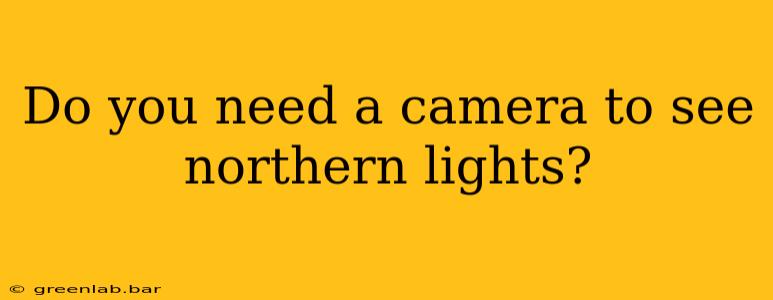The short answer is no, you don't need a camera to see the Northern Lights (Aurora Borealis). However, a camera can significantly enhance your experience and allow you to capture the breathtaking beauty of this natural phenomenon for posterity. Let's delve deeper into why.
Seeing the Aurora with the Naked Eye
The human eye is remarkably adaptable, but it's not perfectly suited to low-light conditions. While you absolutely can see the aurora borealis with your naked eye, the experience might be subtly different than what you see in photographs.
-
Brightness: The aurora's intensity varies greatly. During a strong auroral display, the lights might appear as vibrant curtains of green, sometimes with hints of red, purple, or blue, easily visible to the naked eye. However, during weaker displays, the aurora may appear as a faint glow or shimmer, more easily perceived in your peripheral vision than directly.
-
Color Perception: Your eyes may not capture the full spectrum of colors as readily as a camera's long exposure can. A camera can pick up subtle color variations and details that might be lost to the naked eye.
-
Overall Impression: While seeing the aurora dance across the sky is undeniably magical, even a faint display can feel awe-inspiring in person. The scale and movement are difficult to fully appreciate in a static photograph.
The Role of a Camera in Aurora Viewing
While not necessary to see the aurora, a camera offers several advantages:
Capturing the Unseen
-
Low-light Sensitivity: Cameras, particularly those with good low-light performance (often indicated by a high ISO capability), can detect and record far more light than your eyes can. This allows you to capture details and colors that are imperceptible to the naked eye.
-
Long Exposure Photography: Long exposure photography is crucial for capturing the aurora's dynamic movement and subtle details. By keeping the shutter open for several seconds or even minutes, your camera can collect far more light, revealing the aurora's full glory in the image.
-
Preserving Memories: The fleeting beauty of the aurora borealis is best captured with a camera. Photographs serve as lasting reminders of your incredible experience.
Camera Settings for Aurora Photography
While a detailed explanation of camera settings is beyond the scope of this article, here's a brief overview of key elements:
- Manual Mode (M): Essential for precise control of aperture, shutter speed, and ISO.
- Low ISO (Initially): Start with a low ISO (e.g., 800) and gradually increase if needed.
- Wide Aperture: A wide aperture (low f-number, e.g., f/2.8) lets in more light.
- Long Exposure: Experiment with shutter speeds, starting with a few seconds and increasing as needed.
- Tripod: Absolutely necessary for long exposure shots to prevent blurring.
Conclusion
Ultimately, you can enjoy the magic of the northern lights without a camera. However, a camera equipped with the right settings and a tripod will dramatically enhance both your viewing experience and your ability to share this unforgettable spectacle with others. So, while not a necessity, a camera is a valuable tool for anyone hoping to fully appreciate and remember the aurora borealis.

